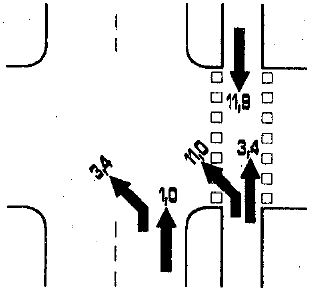Pleas excuse the extreme cutting but the last post was a bit long and even then there was complaints about what I'd cut. I'm not quoting the whole essay so I may as well please myself and cut it really short. Please refer back if you want the full quotes.
Pete Owens wrote:They are expecting and looking for traffic on the main carriageway rather than the cycleway approaching from the other side of the parked cars.
While this is broadly the same direction it is not where drivers are focusing their attention. [...]
Thank you for the clarification: cyclists are indeed coming from the same direction.
The cyclists in the lane are going to cross the main focus of drivers, who will mainly be looking further up the carriageway for cars travelling at higher speeds. Drivers cause plenty of T-bone collisions/near-misses by failing to see carriageway cyclists who are closer to them but moving slower than the cars they were looking for and even this imperfect layout should reduce that.
mjr wrote:The dodgy claimed factor of 3 applies to cycle lanes as well as sidepaths now, does it? These seem to be wonderful statistics like Pooh's words, meaning whatever you want them to mean.
That IS a side path {FFE - family-friendly edit }.
No, it became a painted cycle lane before the junction. I'm sure you don't need me to provide you with a copy of the old paper's diagram with the dodgy 3 clearly labelled on a path crossing half a lane width into the side road - a layout which I think we'd all agree is crap, even if we disagree on the best remedial work and the validity of that stat for other layouts.

[...] You cannot simply dismiss the conflicts as irrelevant since the individual consequences of that particular incident are not severe. Whether an incident is a conflict - or a near-miss or a collision is simply a matter of chance. A high frequency of conflicts is an indicator of a fundamentally dangerous design. That the cyclist happened to be going very slowly at that point was just a matter of chance - this is happening over and over again at every junction along the route - most will be minor conflicts, near-misses will be frequent and eventually some poor cyclist is going to get squished - and I really don't want that cyclist to be my daughter.
Equally, you cannot simply dismiss that these layouts greatly reduce the size of the conflict zone from the legacy layout which has a conflict zone of almost all of at least one lane each way to a few junction zones.
Also, I disagree that what is conflict, near-miss or collision is simply chance because that ignores other factors, but that may not be important right now.
I don't want your daughter - or you, for that matter - squished either. Or anyone else, even those who are physically unable to do what you call "safe cycling practice".
[...] Do you find that throwing verbal abuse at drivers is an effective way of modifying behavior?
Nope. Zen on a bike, me, these days - but I know that there's plenty of other cyclists who will sound off. I'm sure you've seen some.
So you think the safey of cyclists is a laughing matter - you really are beneath contempt.
No, I think your attempt to call things a "near miss" when there's no cyclist anywhere near (and I don't care whether you've stopped to take a pic or stopped for a coffee) are a laughing matter.
Indeed, most confilcts can be resolved in this manner, However...
A minority that cannot will mostly be resolved by an emergency swerve or braking. However ...
A minority of those will fail and result in a minor collision - still no real harm done. However ...
A minority of those collisions will result in someone getting injured - and a minority of those will end up dead.
I agree but there are very few completely conflict-free road layouts, they're fairly constraining and I don't think there's stomach for so many bridges on that sort of street. The question is what reasonable layout best minimises the conflicts and severities, isn't it?
Not really: I'm just mystified why you appear to be so rabidly against an improvement on what went before that you make a laughing stock of yourself by calling things near misses when there's not even a cyclist.
Perhaps because it is my daughters life that is being endangered by the stupidity going on in Manchester that I think this is a serious matter wheras you apparently think it a joke.
Your "near miss" argument is a joke, not the safety. I think the lives of cyclists in Manchester are probably being improved from what was there before, although some things still aren't optimal and I await the comparison data with interest.
[...] Cycling in the door-zone is stupidly dangerous - whichever side you do it on.
How dangerous do you think it is and do you think it's equally dangerous to ride on the side that almost always has a door opened and with live motor traffic alongside as to ride on the side used less where anyone struck would land among walkers?
Maybe we can agree that one lane of parking should be removed ASAP. If it was, how would you allocate the road width?
Modern design would have overcome this danger. [...] The kerb island should either be extended to level with the start of the corner, or cut back to 20m away from the corner.
OK so you agree with me that this is a dangerous design that needs to be urgently removed in the interests of cyclist safety.
I'd say corrected rather than removed, but I'd agree it is currently unnecessarily dangerous with the track-to-lane transition in the grey area.
